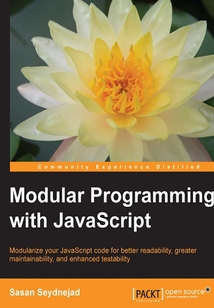舉報 

會員
Modular Programming with JavaScript
最新章節:
Index
IfyouareanintermediatetoadvancedJavaScriptdeveloperwhohasexperienceofwritingJavaScriptcodebutprobablynotinamodular,portablemanner,oryouarelookingtodevelopenterpriselevelJavaScriptapplications,thenthisbookisforyou.AbasicunderstandingofJavaScriptconceptssuchasOOP,prototypalinheritance,andclosuresisexpected.
目錄(75章)
倒序
- 封面
- 版權頁
- Credits
- About the Author
- About the Reviewers
- www.PacktPub.com
- eBooks discount offers and more
- Preface
- What this book covers
- What you need for this book
- Who this book is for
- Conventions
- Reader feedback
- Customer support
- Chapter 1. What Are Modules and Their Advantages?
- Prelude to modular programming
- The simple rule for creating modules
- A real-life example of modules
- A look at a non-modular example
- Re-factoring to a more modularized approach
- Designing in a modular way
- Summary
- Chapter 2. Review of Important JavaScript OOP Concepts
- JavaScript objects
- Summary
- Chapter 3. Module Design Pattern
- Module pattern
- Creating loose coupling among modules
- Summary
- Chapter 4. Designing Simple Modules
- The big picture
- Designing our SPA main pieces
- Summary
- Chapter 5. Module Augmentation
- Principles of module augmentation
- Implementing module augmentation
- Simple augmentation of ImagesInc_GlobalData
- The order of things in module augmentation
- Loose augmentation of modules
- Tight augmentation of modules
- Generating our application's content area
- Summary
- Chapter 6. Cloning Inheritance and Submodules
- Cloning modules
- Creating ImagesInc_Utilites module
- Inheritance in modules
- Submodules
- Summary
- Chapter 7. Base Sandbox and Core Modules
- Application architecture overview
- Base module
- Sandbox module
- Core module
- Components
- Application architectural considerations
- Summary
- Chapter 8. Application Implementation – Putting It All Together
- The user's view of our application
- Application functionality
- Application implementation
- Application components
- GlobalData module
- Summary
- Chapter 9. Modular Application Design and Testing
- Advantages of writing automated tests
- Different types of automated tests
- A simple start to writing our unit tests
- Summary
- Chapter 10. Enterprise Grade Modular Design AMD CommonJS and ES6 Modules
- Revisiting index.html file
- Introducing Asynchronous Module Definition
- CommonJS
- ECMAScript 6 modules
- Summary
- Index 更新時間:2021-07-14 10:56:59
推薦閱讀
- Java性能權威指南(第2版)
- 編譯系統透視:圖解編譯原理
- Responsive Web Design by Example
- SQL Server與JSP動態網站開發
- Python機器學習:預測分析核心算法
- 深入剖析Java虛擬機:源碼剖析與實例詳解(基礎卷)
- TMS320LF240x芯片原理、設計及應用
- HoloLens與混合現實開發
- Java并發編程之美
- C++程序設計教程
- Mastering Android Studio 3
- Python全棧開發:基礎入門
- LibGDX Game Development By Example
- 編程改變生活:用PySide6/PyQt6創建GUI程序(進階篇·微課視頻版)
- Data Visualization:Representing Information on Modern Web
- Java從入門到精通(第7版)
- 天天學敏捷:Scrum團隊轉型記
- Drupal 7 Development by Example Beginner’s Guide
- Android 3D游戲開發技術寶典:OpenGL ES 2.0
- Building a 3D Game with LibGDX
- HTML5+CSS3+JavaScript Web前端開發案例教程(慕課版)
- Python Geospatial Development(Third Edition)
- The Data Analysis Workshop
- WebRTC音視頻實時互動技術:原理、實戰與源碼分析
- JSP從零開始學(視頻教學版)
- 深入理解Java虛擬機:JVM高級特性與最佳實踐(第2版)
- OpenJDK Cookbook
- Learning Azure Functions
- JavaScript at Scale
- WiX Cookbook

